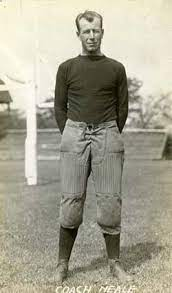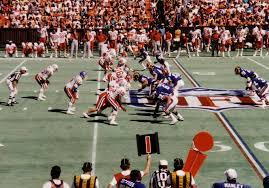John LeRoy Christiansen was an American professional football player who became a college and pro coach. He played professionally in the National Football League for the Detroit Lions as a safety and return specialist from 1951 to 1958. He helped lead the Lions to three NFL championships in 1952, 1953, and 1957 and was a first-team All-NFL player in six of his eight years in the league. He led the NFL in interceptions in 1953 and 1957 and in punt returns for touchdown in 1951, 1952, 1954, and 1956. His eight career punt returns for touchdowns was an NFL record until 1989 and remains the fourth best in league history. He was inducted into the Pro Football Hall of Fame in 1970.
After retiring as a player, Christiansen served as a football coach for 25 years from 1959 to 1983, including stints as the head coach of the San Francisco 49ers, compiling a 26–38–3 record from 1963 to 1967, and at Stanford, where he compiled a 30–22–3 record from 1972 to 1976. He concluded his career as an assistant coach for the Kansas City Chiefs (1977), Seattle Seahawks (1978–1982), and Atlanta Falcons (1983).
Christiansen was selected in the sixth round of the 1951 NFL Draft, 69th overall, by the Detroit Lions. As a rookie in 1951, he appeared in all 12 games as a defensive halfback for the Lions. In his third NFL game, playing in front of "the largest crowd ever to see a football game in Detroit" (52,907 in attendance), he returned two punts for touchdowns (returns of 69 and 47 yards) against the Los Angeles Rams. Six weeks later, Christiansen repeated the feat, returning two punts for touchdowns (returns of 71 and 89 yards) against the Green Bay Packers on Thanksgiving Day in Detroit.[8] He returned 18 punts for a total of 343 yards (19.1 yards per return), as the 1951 Lions compiled a 7–4–1 record and finished in second place in the NFL's Western Division.
In 1952, he helped lead the Lions to an NFL championship, the second in franchise history. Christiansen returned 15 punts for 322 yards and two touchdowns, and his average of 21.5 yards per punt return during the 1952 season remains an NFL record. His longest return in 1952 was for 79 yards with two minutes remaining against the Chicago Bears at Wrigley Field on November 23. Christiansen also played as a halfback on offense, rushing for 54 yards and a touchdown on nine carries against the Chicago Bears on December 7, and for 94 yards, including a 65-yard touchdown run, against the Dallas Texans on December 13. At the end of the season, Christiansen was selected by the Associated Press (AP) as a first-team All-NFL player.
In 1953, Christiansen helped lead the Lions to their second consecutive NFL championship. While his punt return numbers declined (eight returns for only 22 yards), he became a starter at left halfback and developed a reputation as one of the best pass defenders in the NFL. He led the NFL with 12 interceptions, 238 interception return yards, and a 93-yard interception return. Despite playing in only 11 games in 1953, his 12 interceptions remains tied for the fifth highest single-season tally in NFL history. At the end of the season, he was selected by the AP and United Press International (UPI) as a first-team All-NFL player and was invited to play in the Pro Bowl.
Christiansen became an integral part of the defensive backfield, a unit that would become known as "Chris's Crew," in tribute to his leadership. He continued this high standard of play, tying for the interception lead with 10 picks-six in 1957 to help the Lions win their third title in six years. His 46 career interceptions ranks fourth on the Lions' all-time list. As a punt returner, he had 85 returns for 1,084 yards, and his 12.8 average still stands as a Detroit record and is third all-time in NFL history.
He is tied with Lem Barney at 11 for the most return touchdowns in Detroit history. Christiansen still has the team record with eight punt return touchdowns. He was the first player in NFL history to record two punt return touchdowns in the same game.
After winning All-Pro six consecutive years from (1952–1957) and playing in five consecutive Pro Bowls beginning in 1954, Christiansen was inducted into the Pro Football Hall of Fame in 1970. He was an All-NFL defensive back for six-straight years, played in five Pro Bowls (opening the 1956 game with a 103-yard kickoff return) and led the league in interceptions twice.
In January 1959, Christiansen announced that he was retiring as a player to accept a position as an assistant coach with the San Francisco 49ers under head coach Red Hickey. He served as a defensive backfield coach with the 49ers for four years, from 1959 to 1962. In late September 1963, with the 49ers in the midst of a 10-game losing streak, including all five pre-season games and the first three regular-season games of the 1963 season, Hickey resigned, and Christiansen, at age 34, took over as the 49ers' head coach. In that season's final 11 games, the 49ers won only twice, but held the distinction of being the only team to defeat the eventual NFL champion Chicago Bears.
Over the succeeding four years, San Francisco continued to struggle, with Christiansen's best season coming in 1965 when the team was 7–6–1. The 49ers began the 1967 season with five wins in their first six games, but won only two more games the remainder of the campaign, resulting in Christiansen's dismissal on December 20, ending his tenure with a record of 26–38–3.
In January 1968, Christiansen was hired by his alma mater, Colorado State, as a consultant to review and make recommendations concerning the university's athletic program.
In April 1968, Christiansen was hired as an assistant coach under John Ralston at Stanford. During this period, Stanford pulled off consecutive Rose Bowl upsets of Ohio State and Michigan, both previously undefeated In January 1972, Ralston left to coach the NFL's Denver Broncos, and Christiansen was promoted to head coach.
Christiansen spent five years as Stanford's head coach, compiling a winning record each year and a 30–22–3 overall record. He was criticized for starting Mike Cordova rather than Guy Benjamin at quarterback during the 1975 season and for switching between quarterbacks during the 1976 season. One day prior to the final game of the 1976 season, Stanford announced that it was terminating Christiansen as its head coach.
In March 1977, Christiansen was hired as an assistant coach, responsible for running backs, under Paul Wiggin with the Kansas City Chiefs. Wiggin was fired in the middle of the season, as the Chiefs compiled a 2–12 record.
In April 1978, Christiansen was hired by the Seattle Seahawks, replacing Bob Holloway as the team's defensive backfield coach. He spent five years as the Seahawks' defensive backfield coach, from 1978 to 1982.
In February 1983, Christiansen was hired by the Atlanta Falcons as its secondary coach. In January 1984, Christiansen resigned his position with the Falcons after being diagnosed with cancer.
Sources
https://www.pro-football-reference.com/
https://www.profootballarchives.com/index.html
https://americanfootballdatabase.fandom.com/wiki/Football_Wiki
https://www.gridiron-uniforms.com/GUD/controller/controller.php?action=main
https://www.profootballhof.com/hall-of-famers/
"Former NFL star dies after surgery". Eugene Register-Guard. (Oregon). Associated Press. June 30, 1986. p. 2B.
"Jack Christiansen NFL Coaching Record". Pro-Football-Reference.com. Sports Reference LLC. Retrieved March 10, 2016.
"Jack Christiansen College Coaching Record". SR/College Football. Sports Reference LLC. Archived from the original on March 30, 2016. Retrieved March 10, 2016.
"Jack Christiansen". Pro-Football-Reference.com. Sports Reference LLC. Retrieved March 10, 2016.
"Lions great Christiansen dies at 57". Detroit Free Press. July 1, 1986. p. 5D – via Newspapers.com. Open access icon
"Jack Christiansen". Colorado Sports Hall of Fame. Retrieved March 10, 2016.
"52,907 See Rams Gain 27-21 Edge: Christiansen Makes It Close on 2 TD Romps". Detroit Free Press. October 15, 1951. pp. 26, 28 – via Newspapers.com. Open access icon
Bob Latshaw (November 23, 1951). "Lions Wallop Packers, 52-35, as Layne Fires 2 TD Passes". Detroit Free Press. p. 42 – via Newspapers.com. Open access icon
"NFL Single-Season Yards per Punt Return Leaders". Pro-Football-Reference.com. Sports Reference LLC. Retrieved March 10, 2015.
Bob Latshaw (November 24, 1952). "9 Seconds Left -- Bears Shade Lions, 24 to 23: Long Drive Offsets 79-Yard TD Run by Christiansen". Detroit Free Press. p. 32 – via Newspapers.com. Open access icon
Bob Latshaw (December 8, 1952). "Lions Brush Bears Aside, 45-21". Detroit Free Press. p. 37 – via Newspapers.com. Open access icon
"Lions Wallop Dallas, Clinch Tie for Title". Detroit Free Press. December 14, 1952. p. 32 – via Newspapers.com. Open access icon
Bob Latshaw (November 13, 1953). "He's a Dandy on Pass Defense: Lions Love That Chris!". Detroit Free Press. p. 29.
"NFL Single-Season Interceptions Leaders". Pro-Football-Reference.com. Sports Reference LLC. Retrieved March 10, 2015.
Turkin, Hy (December 27, 1953). "7 Browns on NEWS '53 All-Pro". New York Daily News. p. 72 – via Newspapers.com.
George Puscas (January 23, 1959). "'Chris' Takes Leave Of Lions To Coach". Detroit Free Press. p. 29 – via Newspapers.com. Open access icon
"Jack Christiansen Confident He Can Rebuild Forty-Niners". The Daily Herald (Provo, Utah). October 1, 1963. p. 7 – via Newspapers.com. Open access icon
"Lions 'Fear' Former Teammate Christiansen". The Times (San Mateo, CA). October 2, 1963. p. 15 – via Newspapers.com. Open access icon
"Coach Jack Christiansen Fired As 49ers Boss After 7-7 Season". The Danville (VA) Register. December 21, 1967. p. 2D – via Newspapers.com. Open access icon
"Christiansen Gets Job at Colorado St". The Times (San Mateo, CA). January 16, 1968. p. 19 – via Newspapers.com. Open access icon
"Christiansen Joins Stanford Gridiron Staff". Ukiah (CA) Daily Journal. April 11, 1968. p. 2 – via Newspapers.com. Open access icon
"Stanford Job To Assistant Christiansen". The Des Moines Register. January 22, 1972. p. 19 – via Newspapers.com. Open access icon
"Stanford Fires J. Christiansen". The Terre Haute (IN) Tribune. November 20, 1976. p. 8 – via Newspapers.com. Open access icon
"Christiansen Chiefs' aide". Rochester (NY) Democrat and Chronicle. March 31, 1977. p. 2D – via Newspapers.com. Open access icon
"Sports People". Detroit Free Press. April 24, 1978. p. 10 – via Newspapers.com. Open access icon
"Christiansen joins Falcon staff". Detroit Free Press. February 19, 1983. p. 6D – via Newspapers.com. Open access icon
"Christiansen Leaving Atlanta Falcons Staff". The Tennessean. January 25, 1984. p. 14C – via Newspapers.com. Open access icon
"All-Pro Team of 1950s". Racine Sunday Bulletin. August 31, 1969. p. 6C – via Newspapers.com. Open access icon
George Puscas (February 3, 1970). "Jack Christiansen Gains Hall of Fame". Detroit Free Press. p. 1D – via Newspapers.com. Open access icon
"All-time all-pro football team". San Antonio Express. December 11, 1977. p. 4H – via Newspapers.com. Open access icon
George Puscas (May 17, 1986). "Howe was - and is - hockey's 'Great One'". Detroit Free Press. p. 1D – via Newspapers.com. Open access icon
"The Athletic Hall of Fame". Colorado State University. Archived from the original on March 11, 2016. Retrieved March 10, 2016.
"untitled". Democrat and Chronicle (Rochester, NY). August 15, 1999. p. 3D – via Newspapers.com. Open access icon
"Our Top Lions". Detroit Free Press. October 19, 1999. p. 5E






















